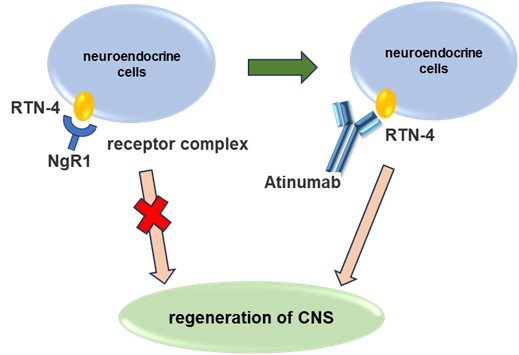Atinumab Overview
Introduction to Atinumab
Atinumab is a highly specialized monoclonal antibody engineered to selectively bind to and neutralize the reticulon-4 (RTN-4) protein in human tissues. RTN-4, commonly referred to as Nogo-A, is a myelin-associated protein that plays a crucial role in the central nervous system (CNS) by inhibiting neuronal regeneration and plasticity. This inhibition is a significant factor in preventing the repair and regrowth of damaged neurons following CNS injuries, such as spinal cord injury, stroke, and neurodegenerative diseases. Atinumab exerts its therapeutic effects by specifically targeting and binding to the RTN-4/Nogo-A protein, thereby neutralizing its inhibitory action on neurons. This neutralization can potentially facilitate an environment conducive to neural repair, promoting axonal growth, synaptic plasticity, and overall nerve regeneration. By counteracting the inhibitory effects of RTN-4, atinumab holds promise for enhancing the regenerative capacity of the nervous system and improving recovery outcomes in various neurological conditions. Atinumab has the capacity to inhibit the RTN-4 protein and block the downstream signals, making itself a significant candidate for treating debilitating conditions where nerve damage and neuronal loss play a key role, which offers hope for improved functional recovery and quality of life for affected individuals.
Biological and Chemical Properties of Atinumab
Protein Average Weight
144,000 Da (average)
The Mechanism of Atinumab Action
The RTN-4 protein serves as a significant inhibitor in the CNS, limiting axonal growth and neuronal regeneration following injury. Atinumab binds to this RTN-4 protein, effectively neutralizing its inhibitory effects. This binding allows for improved axonal growth and neuronal plasticity, which is crucial for nerve repair and functional recovery in conditions such as spinal cord injury, stroke, and multiple sclerosis.
 Figure 1. The Mechanism of Atinumab Action (Creative Biolabs Original)
Figure 1. The Mechanism of Atinumab Action (Creative Biolabs Original)
Targeting and Binding RTN-4
Atinumab specifically targets the extracellular domains of RTN-4/Nogo-A, particularly the Nogo-66 and NiG (Nogo-Interacting) domains, which are critical for its inhibitory functions on neurite outgrowth. By selectively binding to these domains, atinumab effectively blocks the interaction between RTN-4/Nogo-A and its receptors.
Receptor Interaction Inhibition
RTN-4/Nogo-A exerts its inhibitory action primarily by binding with the Nogo-66 receptor (NgR1), forming a receptor complex which involves p75NTR, LINGO-1, and other co-receptors. This receptor complex activates downstream signaling pathways that culminate in growth cone collapse and inhibition of axonal regeneration. By binding to RTN-4/Nogo-A, atinumab interferes with its ability to engage and activate NgR1 and its associated receptor complex components.
Modulation of Downstream Signaling Pathways
The activation of the Nogo receptor complex initiates several intracellular signaling cascades, including the RhoA/ROCK pathway and the PTEN/mTOR pathway, both of which are associated with the inhibition of cytoskeletal dynamics and growth cone mobility. By preventing RTN-4/Nogo-A from interacting with its receptor complex, atinumab effectively abrogates the activation of these inhibitory pathways.
RhoA/ROCK Pathway: RTN-4/Nogo-A binding to its receptors leads to the activation of the small GTPase RhoA, which further activates Rho-associated coiled-coil forming kinase (ROCK). Activated ROCK phosphorylates cytoskeletal proteins, leading to increased actin-myosin contractility and growth cone collapse. Atinumab's inhibition of RTN-4/Nogo-A prevents the activation of RhoA, maintaining cytoskeletal stability conducive to axonal growth.
PTEN/mTOR Pathway: RTN-4/Nogo-A signaling also influences the PTEN (phosphatase and tensin homolog)/mTOR (mammalian target of rapamycin) pathway, crucial for cell growth and axonal regeneration. PTEN acts as an inhibitor of the mTOR pathway. Inhibition of RTN-4/Nogo-A by atinumab may reduce the upregulation of PTEN activity, thus promoting mTOR pathway activation, which supports neuronal growth and repair.
Promotion of Neurite Outgrowth and Neuroplasticity
By neutralizing the inhibitory effects of RTN-4/Nogo-A on neurite outgrowth and neural plasticity, atinumab promotes neural repair mechanisms and supports functional recovery following neural injury. This includes enhancing axonal regeneration, synaptic plasticity, and remyelination processes vital for the restoration of neural networks in the CNS.
Clinical Implications
Atinumab's ability to promote neural regeneration makes it a potential therapeutic candidate for a range of CNS injuries and neurodegenerative disorders where inhibition of RTN-4/Nogo-A is beneficial. This includes conditions such as spinal cord injury, stroke, multiple sclerosis, and other neurodegenerative diseases where enhanced neural repair can significantly improve clinical outcomes.
In summary, atinumab works by specifically targeting and inhibiting RTN-4/Nogo-A, subsequently blocking its interaction with the Nogo receptor complex and preventing the activation of inhibitory intracellular signaling pathways. This inhibition facilitates axonal growth and regeneration, offering significant therapeutic potential for CNS repair and recovery.
Clinical Projects of Atinumab
| NCT ID | Study Title | Study Status | Conditions | Sponsor | Start Date |
| NCT00406016 | Acute Safety, Tolerability, Feasibility and Pharmacokinetics of Intrath. Administered ATI355 in Patients With Acute SCI | COMPLETED | Acute Spinal Cord Injury | Novartis | 2006-05 |
* The table was excerpted from the following website:
https://clinicaltrials.gov/study/NCT00406016?cond=Atinumab&rank=1
For research use only. Not intended for any clinical use.
This site is protected by reCAPTCHA and the Google Privacy Policy and Terms of Service apply.

